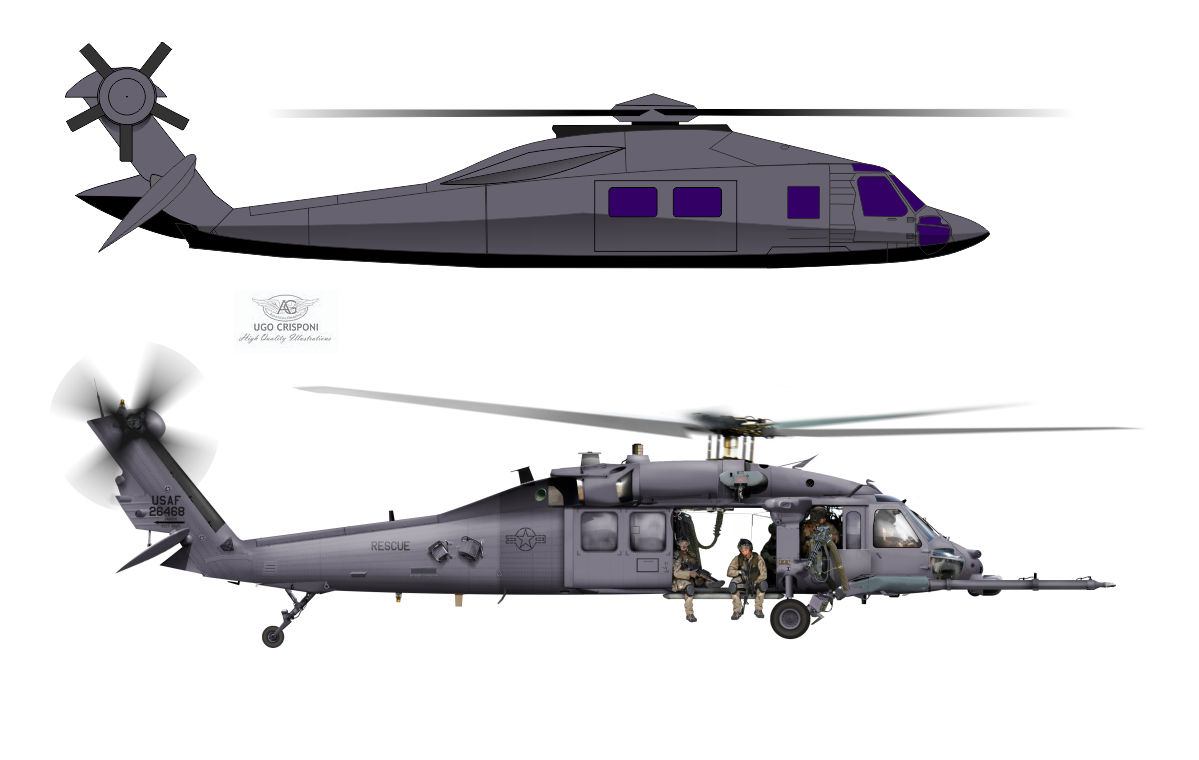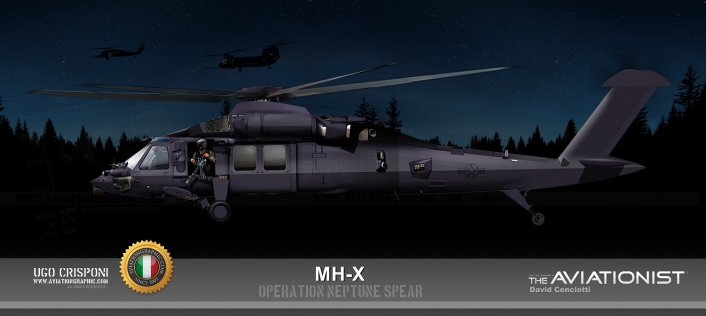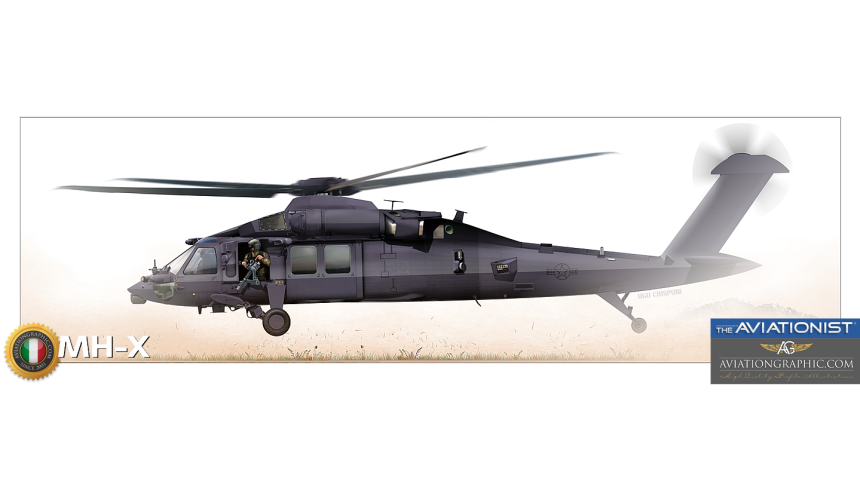Since 2011 we have collected the description of someone who was in Afghanistan and saw the secret MH-X Stealth Black Hawk helicopter recover after the raid. While its shape is still a mystery, here’s an interesting rendering.
On May 3, 2011, few hours after the first images of its remains started to spread around the world, we were among the world’s first aviation sites to write that those parts didn’t belong to any known type of chopper: the helicopters used by the U.S. Navy SEALs in the raid that killed Osama Bin Laden, and in particular the one that had crashed in Abbottabad, Pakistan, was a previously unknown radar evading chopper, flown by the U.S. Army 160th SOAR (A)“Night Stalkers”, that would be later unofficially nicknamed the “Stealth Black Hawk”.
What’s this weird cover on the (presumed) UH-60’s tail? Some sort of stealth device? Never seen before @TheDEWLine http://twitpic.com/4sswqg
— David Cenciotti (@cencio4) May 3, 2011
Indeed, as often explained since then, the tail rotor had an unusual cover that could be anything from an armour plate to a noise reduction cover sheltering the motion-control technology used to input low-frequency variations of rotor blade pitch-angle, as tested by NASA; the blades were flatter, and not wing-shaped, whereas the paint job was extremely similar to the kind of anti-radar paint and Radar-Absorbing Material coating used by the most modern stealth fighters.
According to the few official statements released in the aftermath of the raid, the helicopter did not suffer any failure but skittered around uncontrollably in the heat-thinned air forcing the pilot to crash-land. As it did, the tail and rotor hit on one of the compound’s 12-foot walls. While the U.S. Navy SEALs tried to destroy the crashed helo to hide its technology, the tail section survived the attempt to blow it up because it had fallen outside of the compound giving the world the opportunity to have a glance at an advanced technology developed since the Cold War era, when the U.S. ran a series of black programs aimed to give the U.S. Navy Special teams a platform to penetrate, unseen, the Soviet Air Defenses and hit naval installations and harbours.
The mysterious helicopter involved in the Osama Bin Laden raid http://wp.me/pEfC-1fz
— David Cenciotti (@cencio4) May 3, 2011
What happened next, at least for us it’s very well known: this Author began studying the possible shape of the MH-X or “Stealth Black Hawk” or “Silent Hawk”, immediately after the first pictures of the helicopter’s tail section appeared online. With the help of Ugo Crisponi, an artist at AviationGraphic.com, I imagined what the full stealthy chopper would have looked like after applying the tail section and rotor revealed by the photographs, along with imaginary engine shields, rotor covers, an extra main rotor blade (to slow down the rotor speed making blades quieter) and some imagination.

Although it was based on a few surviving chunk of metal and fantasy (hence fairly inaccurate and resembling an S-76 more than an MH-60), the initial sketch went viral: I was interviewed by media all around the world and the sketch itself was used by news agencies, newspapers, TV broadcasters, documentaries, as if it was the real portrayal of the still secret Stealth Black Hawk. Model kits and diecast helicopters were also based on that concept image. If you Google “Stealth Black Hawk” and search by images, you’ll find many occurrences of the first and subsequent reviews of the rendering, as well as many other artist impressions influenced by them.
Anyway, we continued to work on that first rendering and, in the following days, we published an updated and more refined rendering:

Here’s the rest of the story, as explained in detail in a previous story posted here:
While fictional, it’s worth noticing that the various reviews of the original rendering appear to have something in common with an in-depth study by the Sikorsky Aircraft Division, dated 1978. Indeed, as once again The Aviationist first discovered and reported on May 17, 2011, a document titled: “STRUCTURAL CONCEPTS AND AERODYNAMIC ANALYSIS FOR LOW RADAR CROSS SECTION (LRCS) FUSELAGE CONFIGURATIONS”, issued by Sikorsky Aircraft Division for the US Army Research and Technology Laboratories in 1978 provides some details about a project for a Low Observability UH-60.
Even though the fuselage concepts for low radar cross section aircraft configurations were designed at the end of the ’70s, the first attempts to give the UH-60 some stealthy capabilities are still useful to imagine a few modifications to the “classic” Black Hawk profile that might have made their way into the final Stealth Black Hawk.
Three LRCS fuselage configuration were developed by the Applied Technology Laboratory, both based on tail surfaces and main rotor pylon fairing of the baseline UH-60A.
[…]
The document did not identify a specific LRCS configuration to be used to get a radar-evading Black Hawk but the structural concepts developed for the study and aerodynamic analysis suggested a shape reminding more that of an F-117 than that of a more modern stealth, like the F-22 or F-35.
The Low Observability project may have not been the only study to inspire the shape of the Stealth Black Hawk flying in 2011. Some sources suggest the MH-X may have similarities with the YEH-60B SOTAS (Stand-Off Target Acquisition System) a particular Black Hawk version designed to detect moving targets on the battlefield and downlink the information to an Army ground station.
The only SOTAS built for the U.S. Army (flown in the early 1980s before the program was cancelled in favor of the E-8 JSTARS) had a retractable main gear whose shape could have been used on the MH-X as well. Few more upgrades may have been based on past prototypes, as the ACAP, the Army’s Advanced Composite Airframe Programme, whose goal was the development of an all-composite helicopter fuselage lighter and less costly to build than the predominantly metal airframes in general use.
Other upgrades were probably embedded to reduce the overall Radar Cross Section: a flat windshield with a gold layer for electrical continuity, fairings to cover the push rods and main rotor hub, retractable IFR (In-Flight Refueling) probe, as well as IR suppressors.
Little more has emerged about the Stealth Black Hawks during the last 10 years. The most interesting “updates” date back to the release of “Relentless Strike”, a 2015 book by award-winning defense journalist Sean Naylor. According to Naylor, the two Stealth Black Hawks were the first (and probably only) two prototypes of a classified program whose aim was to make the original Black Hawks less visible to radars. The airframes were built and tested at Area 51, Nevada. The program had been cancelled but once the need to infiltrate the Pakistani airspace emerged, the two almost-experimental airframes were chosen to bring the Special Forces to Abbottabad.
A witness describes the Stealth Black Hawk
While official details have remained at least scarce, among all the hints we have collected throughout the years, we have also received the recollections of someone who happened to be in service in Afghanistan on the night of the OBL and had the opportunity to watch the Stealth Black Hawk.
“I was on the ramp at Bagram that night,” said a reader who wishes to remain anonymous in the first of a series of messages we have exchanged in the last few years (some of those were needed to prove his presence there at Bagram in May 2011). “The Stealth Hawk I saw had, zero markings or numbers whatsoever. They Landed on the JSOC ramp which is Alpha ramp then taxied to the lone “CIA” hangar at about 2-3AM local.”
“It is near silence while taxing. We heard the Pave Hawks way before the stealth hawk. I worked ISR and actually working that night on one of our aircraft. After they taxied by the park in front of the aforementioned hangar, Alpha ramp is dark unlike over ramps at BAF, I slewed the wescam ball toward the aircraft.”
“I actually saw the two Stealth Hawks unloaded off a C-17 a week before raid. Both were fully covered and appear to be same size as a normal Black Hawk.”
“The renderings [you have published] are close but not exact of the stealth. The sides were slopped but not as dramatic as one used in the movie Zero Dark Thirty. Didn’t notice the rotors or main rotor head as it was running and did not see much of those in IR on the Wescam ball when we slewed it over to check it out what was going on when they parked it.”
When I asked to have a look at the latest version of rendering made with Crisponi (that you can find at this link) here’s what he responded: “The bottom one with the style nose of top one is pretty close. I didn’t notice a refuel probe either.”
Based on the details provided by the source, I’ve asked Ugo Crisponi to draw an updated rendering that you can find here in this post (at the top of the article and here below). According to our source, who reviewed the rendering, the shape is close to what he saw, although there were no door gunners. “But they were RTB so guns may have been stowed.”
Obviously, this could still be quite different from the original aircraft. Basically, it remains a work of fantasy, based on some recollections and much imagination. That being said, it could also be the closest artwork to the real thing that you will find before an official reveal is eventually done.










